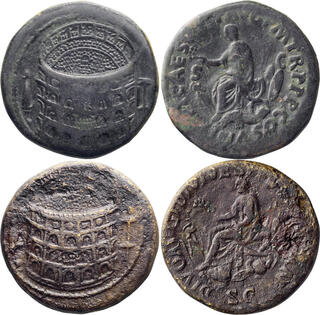Lot description:
Set of Colosseum Sestertii by Titus and Domitian. ; Set of Colosseum Sestertii by Titus and Domitian; Two coins in lot.
Coin #1: Titus; 79-81 AD, Rome, c. 80-81 AD, Sestertius, 27.99g. BM-190 pl. 50.2 (same rev. die), Paris-189 pl. LXXXI (same dies), RIC-184 (R2), Cohen-400 (80 Fr.). Obv: Colosseum seen from front and above between obelisk on base (Meta Sudans) and porticoed building of two stories (Baths of Titus), without legend; Rx: IMP T CAES VESP AVG P M TR P P P COS VIII S - C Titus seated l. holding branch and roll on curule chair set on globe among arms. Ex Gemini XIII, 6 April 2017, lot 162. From a British collection, acquired in 1978 by Paul Munro Walker, Bournmouth. See N.T. Elkins, The Flavian Colosseum Sestertii, Numismatic Chronicle 166, 2006, p. 216, 6, pl. 31 (our dies). To demonstrate the popular nature of Vepasian's rule, the Colosseum was built on the site of Nero's demolished Golden Palace. The reverse type of Titus seated as master of the world (his curule chair set on globe), bringing peace (olive branch) by means of victory over enemies (captured arms), fits well with the recently discovered dedicatory inscription of the Colosseum, stating that the emperors constructed it "from booty" (ex manubis), doubtless chiefly the booty of the Jewish War.
Coin #2: Domitian, Divus Titus; 81-96 AD, Rome, 81 AD, Sestertius, 25.02g. C-399 (80 Fr.), BMC Titus-191 note, RIC-131 (R), pl. 137 (same dies). Obv: No legend. The Flavian amphitheater filled with spectators, seen partly from above; Meta Sudans to l., two-storied porticus of the Baths of Titus to r. Rx: DIVO AVG T DIVI VESP F VESPASIAN Togate Titus seated l. on curule chair, holding branch and roll, and placing his feet on a captured cuirass; the curule chair rests on a globe, and other captured shields, spears, and a helmet are scattered before, below, and behind the emperor; S C in exergue. Titus himself struck the first Colosseum sestertii, but their production was then briefly continued by Domitian for Divus Titus, using one of the same Colosseum obverse dies that Titus had already used, coupled with two new reverse dies naming Divus Titus. Elkins knew just ten specimens of this Colosseum sestertius struck by Domitian for Divus Titus.To the best of our knowledge, a pair of Colosseum sestertii of this original period has never been offered together.
The only other Colosseum coins issued are an exceptionally rare aureus and sestertius issued by Severus Alexander in 223, to commemorate the re-opening of the Colosseum after it had been struck by lightning in about 218, under the reign of Macrinus. These coins were struck 142 years after the coin of Domitian.
Further study in the British Royal Numismatic Chronicle of 2006, in an article by Nathan T Elkins, "The Flavian Colosseum Sestertii: Currency or Largess?" shows that our Titus Colosseum is Elkins 7, of which 11 examples are recorded. But in total, there are about 40 examples from all recorded dies. Of Domitian colosseums, there are 10 recorded by Elkins. Our die is Elkins 9, of which there are six recorded, giving us a total of 10 by both dies, with our coin being the eleventh. Our coin is certainly unrecorded, as when we obtained it, it was in a slab from a far-less-used slabbing company, identified as Titus, and listed as corroded. In fact, our coin was not truly corroded at all, but rather heavily encrusted, and when it was artfully cleaned, it revealed the legend "DIVUS TITUS", which made it the excessively rare issue of Domitian.
These coins are expected to feature in multiple upcoming publications; our Titus Colosseum is anticipated to replace #625B in David Hendin's "Guide to Biblical Coins" after the current 6th edition sells out. In this edition of David Hendin's Book, he lists the Domitian issue of the Colosseum, #626, as "RRR", the highest level of rarity. Even though this coin is listed in his book, it is not illustrated.
Additionally, Whitman has hired Harlan J Berk to re-write Zander Klawans's book on Greek and Roman coins; in that book, this coin will certainly be illustrated.
This pair of Colosseum Sestertii is being offered only as a pair at this FIXED PRICE of $325,000.
. Coin #1: VF
Coin #2: Some isolated corrosion, otherwise EF / VF
Estimate: 325000 USD |  |